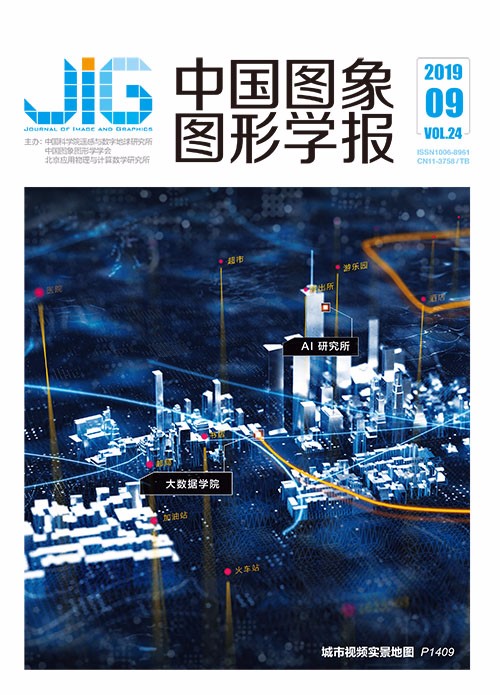
多尺度判别条件生成对抗网络的前列腺MRI图像分割方法
摘 要
目的 由MRI(magnetic resonance imaging)得到的影像具有分辨率高、软组织对比好等优点,使得医生能更精确地获得需要的信息,精确的前列腺MRI分割是计算机辅助检测和诊断算法的必要预处理阶段。因此临床上需要一种自动或半自动的前列腺分割算法,为各种各样的临床应用提供具有鲁棒性、高质量的结果。提出一种多尺度判别条件生成对抗网络对前列腺MRI图像进行自动分割以满足临床实践的需求。方法 提出的分割方法是基于条件生成对抗网络,由生成器和判别器两部分组成。生成器由类似U-Net的卷积神经网络组成,根据输入的MRI生成前列腺区域的掩膜;判别器是一个多尺度判别器,同一网络结构,输入图像尺寸不同的两个判别器。为了训练稳定,本文方法使用了特征匹配损失。在网络训练过程中使用对抗训练机制迭代地优化生成器和判别器,直至判别器和生成器同时收敛为止。训练好的生成器即可完成前列腺MRI分割。结果 实验数据来自PROMISE12前列腺分割比赛和安徽医科大学第一附属医院,以Dice相似性系数和Hausdorff距离作为评价指标,本文算法的Dice相似性系数为88.9%,Hausdorff距离为5.3 mm,与U-Net、DSCNN(deeply-supervised convolutional neured network)等方法相比,本文算法分割更准确,鲁棒性更高。在测试阶段,每幅图像仅需不到1 s的时间即可完成分割,超出了专门医生的分割速度。结论 提出了一种多尺度判别条件生成对抗网络来分割前列腺,从定量和定性分析可以看出本文算法的有效性,能够准确地对前列腺进行分割,达到了实时分割要求,符合临床诊断和治疗需求。
关键词
Prostate MRI segmentation by using conditional generative adversarial networks with multi-scale discriminators
He Jun1, Wu Congzhong1, Ding Zhenglong2, Xu Liangfeng1, Zhan Shu1(1.School of Computer and Information, Hefei University of Technology, Hefei 230009, China;2.Anhui Institute of Information Technology, Wuhu 241000, China) Abstract
Objective Information on the size, shape, and location of the prostate relative to adjacent organs is important in surgical planning for prostatectomy, radiation therapy, and emerging minimally invasive therapies. The images obtained by MRI (magnetic resonance imaging) have the advantages of high resolution and good soft tissue contrast, thereby enabling doctors to obtain the required information accurately. Accurate prostate MRI segmentation is an essential pre-processing task for computer-aided detection and diagnostic algorithms. The segmentation of the prostate in MR is challenging because the prostate shows a wide variety of morphological changes, as well as the contrast of the prostate and adjacent blood vessels, bladder, urethra, rectum, and seminal blood vessels. It also has inherently complex changes in intensity. However, manual segmentation from MR images is time consuming and subjective to limited reproducibility. It heavily depends on experience and has large inter- and intra-observer variations. Consequently, an automated or semi-automated prostate segmentation algorithm that provides robust and high-quality results for a wide variety of clinical applications is required. Therefore, an MRI-conditional generative adversarial network with multi-scale discriminators is proposed to automatically segment prostate MRI to satisfy the requirements of clinical practice. Method The proposed segmentation method is based on a conditional generative adversarial network, which consists of a generator and a discriminator. The generator inputs MRI and noise and performs downsampling after a series of two-stride convolution operations. It then performs upsampling after a series of half-stride deconvolution operation resizing to input size. The purpose of the generator composed of the convolutional neural network similar to U-Net is to model a mapping function from the MRI to the prostate region. We propose a multi-scale discriminator with the same structure but different input sizes. The discriminator with the smallest input size has the largest receptive field, which has a global view of the image and can guide the generator to generate a global continuous prostate region. The discriminator with a large input size guides the generator to generate fin details, such as prostate boundary. The structure of the discriminators inherits the patchGAN in pix2pix, which is mapped from an input to an N×N array of outputs, where each element indicates whether the corresponding patch in the image is true or false. In addition, to obtain a stable training, the proposed method uses feature matching loss, which extracts the feature map of the actual image and the generative image from the convolutional network to define the loss function. The network is trained by minimizing the feature loss function, and the difference between the generative image and the actual image is learned. Thus, the generative image and the actual image are more similar in feature. The adversarial training mechanism is used in the training process of the network to iteratively optimize the generator and the discriminator until they converge simultaneously. The generator can be considered as a prostate segmentation network after training. Result The experimental data are obtained from PROMISE12 prostate segmentation challenge and the First Affiliated Hospital of Anhui Medical University. Some of the images are used as training, and some images are used as test. The Dice similarity coefficient and Hausdorff distance are used as evaluation indicators. The Dice similarity coefficient is 88.9%, and Hausdorff distance is 5.3 mm. Our results show that the proposed algorithm is more accurate and robust than U-Net, DSCNN(deeply-supervised convolutional neured network), and other methods. We also compare the segmentation time. During the test phase, each picture is obtained at less than one second to complete the segmentation beyond the speed of the specialist doctor. Conclusion A conditional generative adversarial network with multi-scale discriminators is proposed to segment prostate MRI. The qualitative and quantitative experiments show the effectiveness of the proposed algorithm. This method can effectively improve the robustness of prostate segmentation. More importantly, it satisfies real-time segmentation requirements and can provide a basis for clinical diagnosis and treatment. Therefore, the proposed model is highly appropriate for the clinical segmentation of prostate MRI.
Keywords
magnetic resonance imaging (MRI) prostate segmentation generative adversarial networks (GANs) generator discriminator
|



 中国图象图形学报 │ 京ICP备05080539号-4 │ 本系统由
中国图象图形学报 │ 京ICP备05080539号-4 │ 本系统由